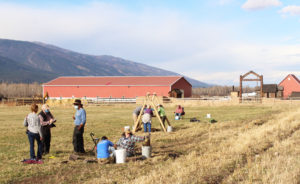
The initial archeological survey of the grounds that will be covered over by a proposed parking lot at the entrance to historical Fort Owen State Park in Stevensville has already yielded one small artifact that lead archeologist at the site, Dan Hall of Western Cultural, Inc., called “significant.” The item has been identified as a frizzen, historically called the “hammer” or the steel, an “L”-shaped piece of steel hinged at the front used in flintlock firearms. Using a Springfield Firearms catalogue, Hall was able to determine that this particular frizzen came from a U.S. Model 1835-1840 Springfield flintlock rifle, meaning the rifle was manufactured between 1835 and 1840.
Hall said that the survey being done on approximately one acre adjacent to the state park was part of the Environmental Analysis being conducted for the construction of the parking lot. He said the cultural survey was very limited in scope and would help answer three basic questions about the site. Number one, is there a deposit of any artifacts to be found on the site? He said that question has been answered by a few surveys involving Lidar Surveying and surveying with a metal detector. He said the Lidar survey was not very helpful on such a small, relatively flat acre of land. But using a metal detector they were able to identify several potential artifacts and a couple of “clusters” of artifacts, which may indicate some sort of building.
The second question to be answered is, are any of the artifacts “significant”?
That’s when Hall showed some real enthusiasm as he reached into his bag and pulled out a rusty looking little object and, like some kid showing us the frog he found down at the pond, Hall showed off the rusty old frizzen his crew had uncovered.

“The answer to the second question is yes,” said Hall, “this is significant.” And he explained what it was and how it functioned in the old flintlock rifle.
The fact that some of the artifacts are in close group clusters is significant in itself, according to Hall. It may indicate a building or some sort of construction site. At this point he produced another metal item just brought in from one of the cluster sites that they were digging into. It was a square nail, also indicating some sort of construction.
Not everything found is significant, or at least not in any historical sense. Unless you find it significant that someone was drinking a canned soda on the site back in the old days when the pull top tab would come completely off and be discarded. I guess that was some sort of historical epoch.
But to make some significant finds, like a frizzen or a square nail, just outside the entrance to the old Fort grounds was not unexpected. After all, it was one of the earliest developments on the frontier in this region and was a magnet for travelers, traders and tribes in the area.
The archeological investigation of the site also has a long history. Hall, himself, as a student was involved in the first major archeological survey of the area over 30 years ago. The trove of artifacts from that survey are now housed in a special climate controlled storage unit at the University of Montana and the subject of a Masters Thesis at the UM published by Donald Merritt in 2010 entitled “Fort Owen: The history and archeology of a contact period site in Western Montana.”
Once this limited scope survey is accomplished, a decision will be made about whether a more complete recovery of artifacts is justified and if so would it be cost effective to retrieve it. Such a circumstance could delay construction of the proposed parking lot but would not stop the project from being completed.

Besides Hall and the crew from Western Cultural, Inc. there are also local volunteers from the Friends of Fort Owen on hand to help with the project. Some of the help comes with a lot of valuable experience in these sorts of projects, like Chris Weatherly, a local carpenter skilled in historical restoration work and Phillip Maechling, vice-president of the Friends of Fort Owen and principal planner for Historic Preservation and Planning in Missoula for 11 years, now retired.
Provided nothing unusual holds up the works, the plan is to start the construction of the parking lot this spring. The state historic site has been operated since its inception with inadequate parking which limited visitation and interfered with the working of the private ranch surrounding it. FWP recently approved the acquisition of the adjacent acreage for the parking lot and contracted with Western Cultural, Inc. for the cultural resources survey.